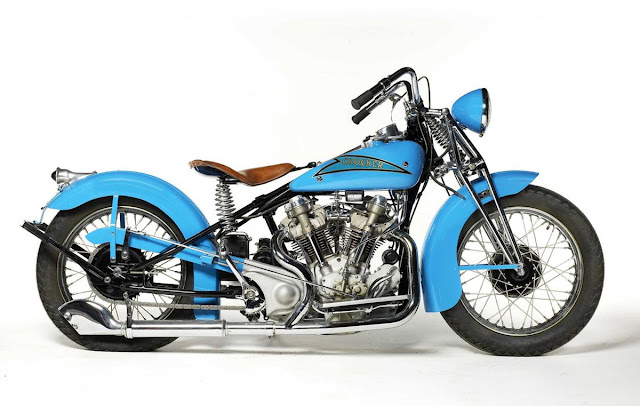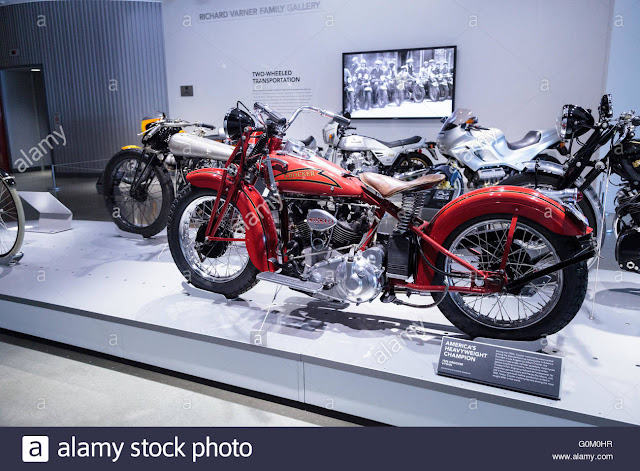The Crocker was a neat looking bike, especially when its aluminium gas tank was highlighted by a scalloped paint finish, but most of all the big V-twin was outstanding for its speed, light weight and high quality engineering. It was unfortunate for maker Al Crocker that too few riders could afford to pay for his upmarket machine.
Albert Crocker was one of the outstanding figures of American motorcycling in the years before the Second World War. He was a dealer and entrepreneur as well as a rider, designer and engineer. And the big lOOOcc V-twins that bore his surname were some of the fastest and most desirable machines on the road.
Crocker worked as a rider and engineer for Thor before becoming an Indian agent in Denver, Colorado, then Kansas City and finally Los Angeles. In LA he developed a speedway racing bike, in conjunction with a young engineer named Paul Bigsby. Their first efforts were powered by the 750cc V-twin engine from an Indian Scout, but on the tight speedway tracks this was at a disadvantage against smaller single-cylinder rivals.
The duo’s next move was to design a 500cc single engine, with an overhead-valve, pushrod- operated layout. This produced about 40bhp. good for 65mph (105km/h) on short speedway gearing, and weighed a competitive 2401b (109kg). Brothers Jack and Cordy Milne, who would later win speedway’s world title aboard JAP-engined bikes,helped develop the Crocker and had some good results on it. But the American bike lacked power compared to its British JAP rival, and Crocker turned his sights to a roadgoing bike.
In 1936 he debuted a V-twin that owed much to his single’s design, and had its cylinders set at 45 degrees. As a competition enthusiast, Crocker had a passion for light bikes with plenty of power. His hemi-head, ohv pushrod V-twin had exposed valve springs and produced an impressive 50bhp at 5800rpm. Its three-speed gearbox was of notably heavy-duty construction, and was cast integral with the frame, with steel plates on either side to allow it to be aligned with the engine.
To reduce weight Crocker used aluminium for numerous components including the fuel tank, instrument panel, engine and generator cases, footboards, and rear light. The result was that the V-twin weighed a very competitive 4801b (218kg), making it considerably lighter than Harley’s new Knucklehead, as well as lObhp more powerful. It was a handsome and well-engineered machine, with raised handlebars, girder front suspension and a rigid rear end with sprung saddle for the rider.
The Crocker roared to a top speed of about 1 lOmph (177km/h), and had looks to match. It was a well-made machine in typical period style, with pulled-back handlebars, a large round headlamp, and a two-into-one exhaust system. The bikes were hand-built, some with engine specification modified at the request of customers. But sadly for A1 Crocker, despite his bikes’ quality his business found it hard to compete with the higher volumes and lower prices of rival firms.
It was Crocker's misfortune that his V-twin was released just as Harley came out with its overhead- valve Knucklehead. Although the Harley was heavier and less powerful, the much larger and better established Milwaukee marque’s bike cost roughly $150 less than the Crocker, which sold for upwards of $500. While the Knucklehead was hugely successful and became the model on which so many later Harleys were based, fewer than 100 examples of the more exotic Californian machine were produced.
From 1939 onwards Crocker also built a scooter called the Scootabout, but this was also produced only in small numbers. He had been hoping that Indian, with which he still had links, would buy rights to manufacture the V-twin. But his plans were dashed by the advent of the Second World War. and Crocker did not restart production of his excellent but unprofitable machine.
Crocker’s robust three-speed gearbox was operated by a hand change, complete in this bike’s case with a dice-style customized shift-lever knob. Top speed exceeded 1 OOmph (161 km/h).
The Crocker V-twin produced 50bhp and was very well engineered. This later model has enclosed pushrod tubes as well as dual oil pumps, a standard Crocker touch that contributed to the bike’s high price.
Specification Crocker V-Twin (1936)
- Engine Air-cooled ohv four-valve pushrod 45-degree V-twin
- Capacity 998cc
- Maximum power 50bhp @ 5800rpm
- Transmission Three-speed, chain final drive
- Frame Steel single downtube
- Suspension Springer forks; rigid rear
- Brakes Drum front and rear
- Weight 480lb (218kg)
- Top speed 110mph (177km/h)


















0 comments: